Link Dump 2009.01.24
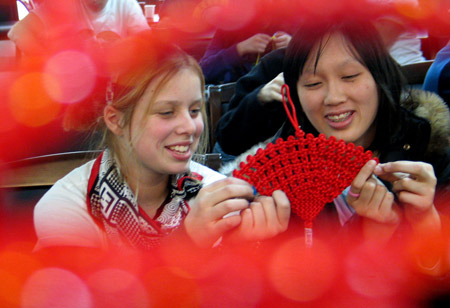 Tomorrow is Lunar New Years’ Eve, so I thought I would bump up my usual Sunday link dump to Saturday on the off chance it helps anyone get out to an event on time…
Tomorrow is Lunar New Years’ Eve, so I thought I would bump up my usual Sunday link dump to Saturday on the off chance it helps anyone get out to an event on time…
 Tomorrow is Lunar New Years’ Eve, so I thought I would bump up my usual Sunday link dump to Saturday on the off chance it helps anyone get out to an event on time…
Tomorrow is Lunar New Years’ Eve, so I thought I would bump up my usual Sunday link dump to Saturday on the off chance it helps anyone get out to an event on time…
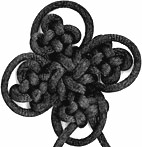 In the book as a variation, so I tied it, the 4-flower inset ears could be any knot. Simply tie 3 in your cord and then lay out your good luck knot with the knots at the end of the cross shape and tie as as you would the good luck with inset ear. Ms. Chen stops there, but why would you want to do that? When done, your cord ends hang in the 4th side ear. So, tie another flower (or whatever you’ve decided to put in your ears 8).
In the book as a variation, so I tied it, the 4-flower inset ears could be any knot. Simply tie 3 in your cord and then lay out your good luck knot with the knots at the end of the cross shape and tie as as you would the good luck with inset ear. Ms. Chen stops there, but why would you want to do that? When done, your cord ends hang in the 4th side ear. So, tie another flower (or whatever you’ve decided to put in your ears 8).
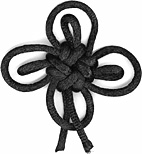 I have this vague recollection that Lydia Chen hadn’t really named the
variants in her Chinese Knotting 3
book, they were more like “variant A” and “variant B”. Whether
numbered or named with poetry, I just wanted to see what she was
naming things and check if it was different in the English
version, but where was my book? Not on the shelf where it’s
supposed to be with one and two. Not in the
bedroom where I might have piled it upon unpacking from the last trip.
Not in the living room, not here, not there, still not here, etc. I
must have wasted most of a day looking without success.
I have this vague recollection that Lydia Chen hadn’t really named the
variants in her Chinese Knotting 3
book, they were more like “variant A” and “variant B”. Whether
numbered or named with poetry, I just wanted to see what she was
naming things and check if it was different in the English
version, but where was my book? Not on the shelf where it’s
supposed to be with one and two. Not in the
bedroom where I might have piled it upon unpacking from the last trip.
Not in the living room, not here, not there, still not here, etc. I
must have wasted most of a day looking without success.
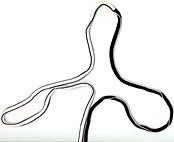 To start a 4
sided good luck knot, fold your cord in half and put
it down, then pull 2 arms out of the side to make a plus (+) shape.
To start a 4
sided good luck knot, fold your cord in half and put
it down, then pull 2 arms out of the side to make a plus (+) shape.
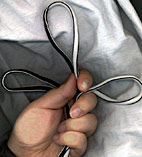 The longer your arms, the easier they are to control
and, obviously, the more working length you need for your cord. While
the surface you’re working on is likely to have more friction than a
polished scanner glass, even so the cord can still get pretty unruly
like the picture to the left.
The longer your arms, the easier they are to control
and, obviously, the more working length you need for your cord. While
the surface you’re working on is likely to have more friction than a
polished scanner glass, even so the cord can still get pretty unruly
like the picture to the left.

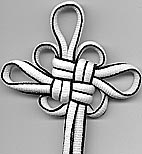 The good luck knot (吉祥結), a name coined by Lydia Chen who wrote the seminal book Chinese Knotting in both Chinese and English, is based on the crown knot. Usually the crown knot is tied in sequence to create a sinnet, a braid composed of knots. The best static (not animated) instructions I have found on the net for the crown sinnets are by The Boondoggle Man who, unfortunately, calls them the square stitch and the circle stitch.
The good luck knot (吉祥結), a name coined by Lydia Chen who wrote the seminal book Chinese Knotting in both Chinese and English, is based on the crown knot. Usually the crown knot is tied in sequence to create a sinnet, a braid composed of knots. The best static (not animated) instructions I have found on the net for the crown sinnets are by The Boondoggle Man who, unfortunately, calls them the square stitch and the circle stitch.